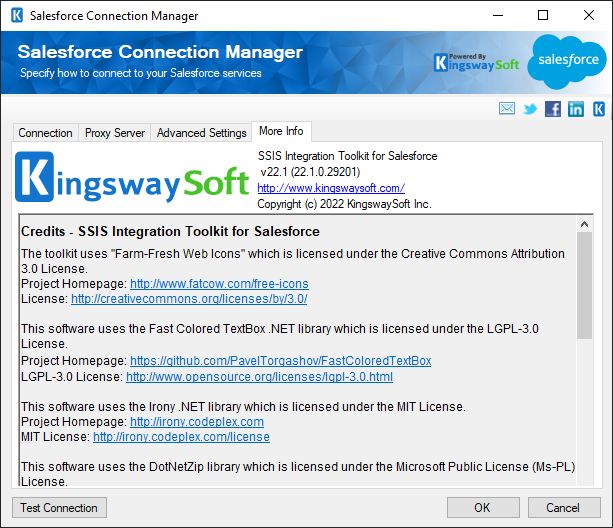Using the Salesforce Connection Manager
The Salesforce Connection Manager is an SSIS connection manager that can be used to establish connections with Salesforce Server. It allows you to specify how you want to connect to Salesforce.com.
To add a Salesforce connection to your SSIS package, right-click in the Connection Managers area, and choose "New Connection..." from the context menu.
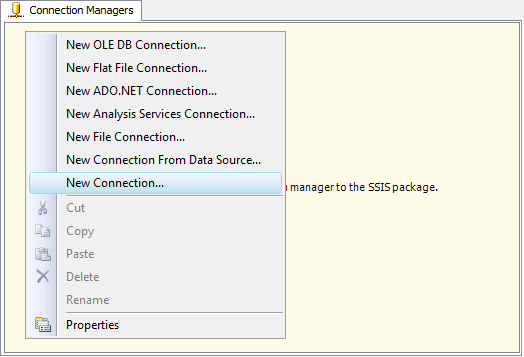
You will be prompted the following window, where you can choose the "Salesforce (KingswaySoft)" or "Salesforce" (deprecated) item to add the connection.
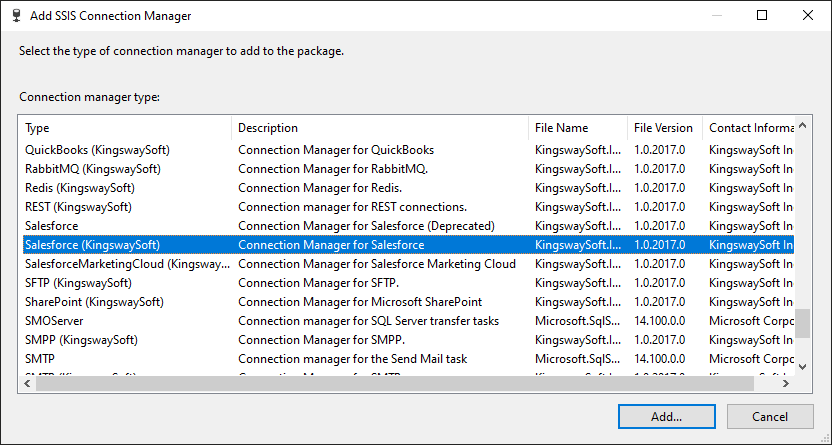
Note that since v7.0 release, you can see two Salesforce connection managers available from us in the list. We recommend you use the "Salesforce (KingswaySoft)" one to avoid any potential conflicts with other vendor solutions. The two connection manager types work exactly the same, but the "Salesforce" one is now considered a deprecated connection after the v7.0 release.
Salesforce Connection Manager contains the following four pages which configure how to connect to the Salesforce service:
- Connection
- Proxy Server
- Advanced Settings
- More Info
Connection Page
The Connection page of Salesforce Connection Manager allows you to specify the general settings of the connection. The connection supports two service endpoints - SOAP and REST.
The below is a SOAP based connection configuration (All SOAP related OAuth configurations below are available since v25.2):
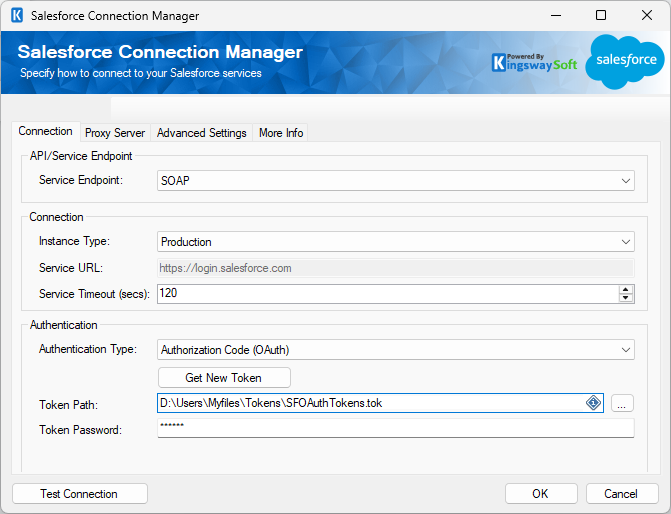
And the one here is a REST based connection configuration:
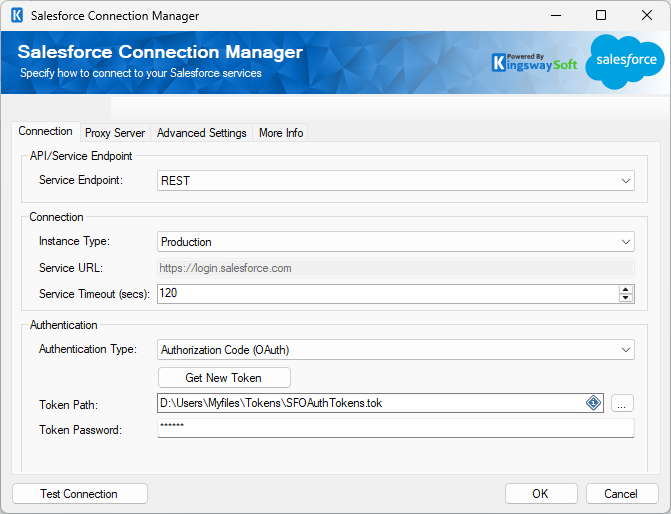
In the upcoming sections, you would see that these two are comparable in terms of OAuth configurations. And the additional item in SOAP is the legacy Basic authentication approach.
- API/Service Endpoint
-
- Service Endpoint
-
The Service Endpoint option allows you to specify the API you want to connect to Salesforce with. There are two options available:
- SOAP
- REST
-
- Connection
-
- Instance Type
-
The Instance Type option allows you to specify what Salesforce instance you are connecting to. There are three options available:
- Production
- Sandbox
- Other
For the first two options, the Service URL option below will be automatically populated. In the case the " Other" option is selected, you can specify an alternate Service URL which may not be a default one. This can be used for the case that you are connecting to a special Salesforce deployment including the situation that you use your own custom domain for Salesforce access.
- Service URL
-
Using this option to provide an alternate URL that will be used to post transactions to your Salesforce instance. This field is only available when the Instance Type option above has been selected as "Other", for the other two options (Production and Sandbox), the Service URL is automatically populated using a default value.
- Service Timeout (secs)
-
The Timeout (secs) option allows you to specify the maximum number of seconds that the Salesforce Connection Manager will wait while trying to establish a connection with the Salesforce service.
- Authentication
-
- Authentication Type (Available only with both SOAP and REST Service Endpoint)
-
This option allows you to specify the preferred type of authentication you want to use when connecting to Salesforce's REST or SOAP API. The below options available:
- Authorization Code (OAuth) - both REST and SOAP
- Client Credentials with Certificate (OAuth) - both REST and SOAP
- Client Credentials with Password (OAuth) - both REST and SOAP
- Username and Password (Legacy, SOAP only)
- Authorization Code Authentication Type:
-
- Get New Token
-
This button completes the OAuth authentication process in order to generate a new token.
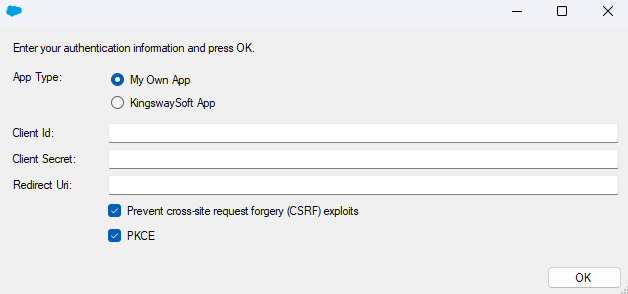
- App Type
-
- KingswaySoft App (since v25.1):
-
KingswaySoft OAuth app is a publicly shared app, it is provided so that you can get test our software without going through the process of creating an app. However it not recommended for any production use, as we cannot guarantee that our app is always available
- My Own App
-
Selecting this option will allow you to use your own Client ID and Secret to connect to Salesforce.
-
- Client Id: The Client Id option allows you to specify the unique ID which identifies the application making the request.
- Client Secret: The Client Secret option allows you to specify the client secret belonging to your app.
- Redirect Url: The Redirect Url option allows you to specify the Redirect Url to complete the authentication process.
- Prevent Cross-Sit Request Forgery (CSRF) exploits: Cross-site request forgery(CSRF) is an attack that can cause the user to perform unwanted actions web pages the user is authenticated on. The option is turned on by default and can be turned off if necessary.
- PKCE (Proof Key for Code Extension) (since v25.1):: Ensures that the client that initiates the OAuth flow is the same client that completes flow. This option would need to be set in the Salesforce connected app or as an org-wide option.
- Token Path
-
The path to the token file on the file system.
- Token Password
-
The password to the token file.
- Client Credentials Certificate Authentication Type:
-
- Client Id
-
The Client Id option allows you to specify the unique ID which identifies the application making the request.
- Certificate Thumbprint
-
The Certificate Thumbprint option is only available when the Certificate OAuth Type has been chosen, it allows you to specify the thumbprint of the certificate created for the application you have created.
- User Name
-
The User Name option allows you to specify the user account used to connect to Salesforce.com for your integration purpose.
- Authorize Button
-
By clicking the Authorize button, it pops up a window to help you authorize the application to access your Salesforce data. All you need to do is to provide the Redirect URL depending on the client application.
- Client Credentials Password Authentication Type:
-
- Client Id
-
The Client Id option allows you to specify the unique ID which identifies the application making the request.
- Client Secret
-
The Client Secret option allows you to specify the client secret belonging to your app.
- User Name
-
The User Name option allows you to specify the user account used to connect to Salesforce.com for your integration purpose.
- Password
-
The Password option allows you to specify a password for the above user in order to be able to log in to the Salesforce service.
- Security Token
-
The Security Token option is used to specify the security token that you have requested in Salesforce.com. If you do not have a security token yet, you must request one by resetting your security token. To do so, login to Salesforce.com, click Your Name | My Settings | Personal | Reset Security Token, and then click the Reset My Security Token button. The new security token is sent via email to the email address on your Salesforce user record. Note that there is no way to retrieve your security token from Salesforce. In case you have lost it, you must request a new one by resetting it again. If you ever need to do so, make sure that you update the security token setting of any other applications that might be using the same authentication.
- Username and Password (Legacy SOAP only) Authentication Type:
-
- User Name
-
The User Name that you use to connect to your Salesforce account.
- Password
-
The Password for the above user in order to be able to log in to the Salesforce service.
- Security Token
-
The Security Token option is used to specify the security token that you have requested in your Salesforce instance. You can follow the above steps from Client Credentials Password Authentication Type section to get a security token if you do not have one.
- Test Connection
-
After you have provided all connection information, you may click the "Test Connection" button to test if you can successfully log in to Salesforce.
Proxy Server Page
The Proxy Server page of Salesforce Connection Manager allows you to specify a proxy server in order to connect to the Salesforce service.
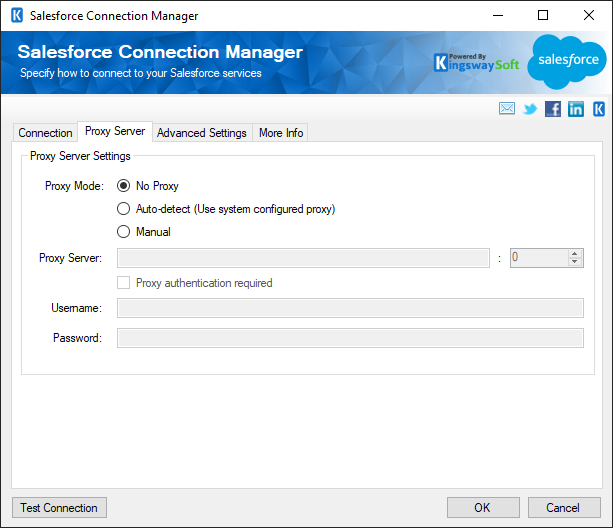
- Proxy Server Settings
-
- Proxy Mode (since v6.0)
-
The Proxy Mode option allows you to specify how you want to configure the proxy server setting. There are three options available.
- No Proxy
- Auto-detect (Using system-configured proxy)
- Manual
- Proxy Server
-
Using the Proxy Server option, you can provide a proxy server to connect to Salesforce.com.
- Port
-
The Port option allows you to specify the port number of the proxy server for the connection.
- Username (Proxy Server Authentication)
-
The Username option (under Proxy Server Authentication) allows you to specify the proxy user account.
- Password (Proxy Server Authentication)
-
The Password option (under Proxy Server Authentication) allows you to specify the proxy user's password.
Note: The Proxy Password is not included in the connection manager's ConnectionString property by default. This is by design for security reasons. However, you can include it in your ConnectionString if you want to parameterize your connection manager. The format would be ProxyPassword=myProxyPassword; (make sure you have a semicolon as the last character). It can be anywhere in the ConnectionString.
Advanced Settings Page
The Advanced Settings page of Salesforce Connection Manager allows you to specify some advanced options when connecting to Salesforce service.

- Optional Headers
-
- Allow Save on Duplicate
-
When this option is enabled, the service calls made to Salesforce will contain a header option that indicates that duplicates are allowed.
- Allow Field Truncation
-
When this option is enabled, the service calls made to Salesforce will contain a header option that indicates that field truncation is allowed.
- Assignment Rule
-
Using this option, you can specify the assignment rule to be fired when a lead or case is created using the Salesforce destination component. The input of this field should be the ID of the assignment rule in Salesforce. You can get an assignment rule's ID by navigating to the assignment rule record in Salesforce, the ID should be the last part of the URL, which generally consists of 18 characters.
- Use Default Assignment Rule (since v8.0)
-
This option allows you to use the default (active) assignment rule for a Case/Lead or apply all territory assignment rules to the Account.
- Advanced Error Handling
-
- Retry on Intermittent Errors
-
This is an option designed to help recover from possible intermittent outages or disruption of service so the integration does not have to be stopped because of such temporary issues. Enabling this option will allow service calls to be retried upon certain types of failure. A service call may be retried up to 3 times before an exception is fired. Retries occur after 0 seconds, 15 seconds, and 60 seconds.
Warning: Although we have designed our retry feature carefully so that the retry should only happen when it is deemed to be safe to do so. However, on some occasions, such retry service calls could result in the creation of duplicate data.
More Info Page
The More Info page shows some basic information about the toolkit. On this page, you can find the version information of the toolkit.
